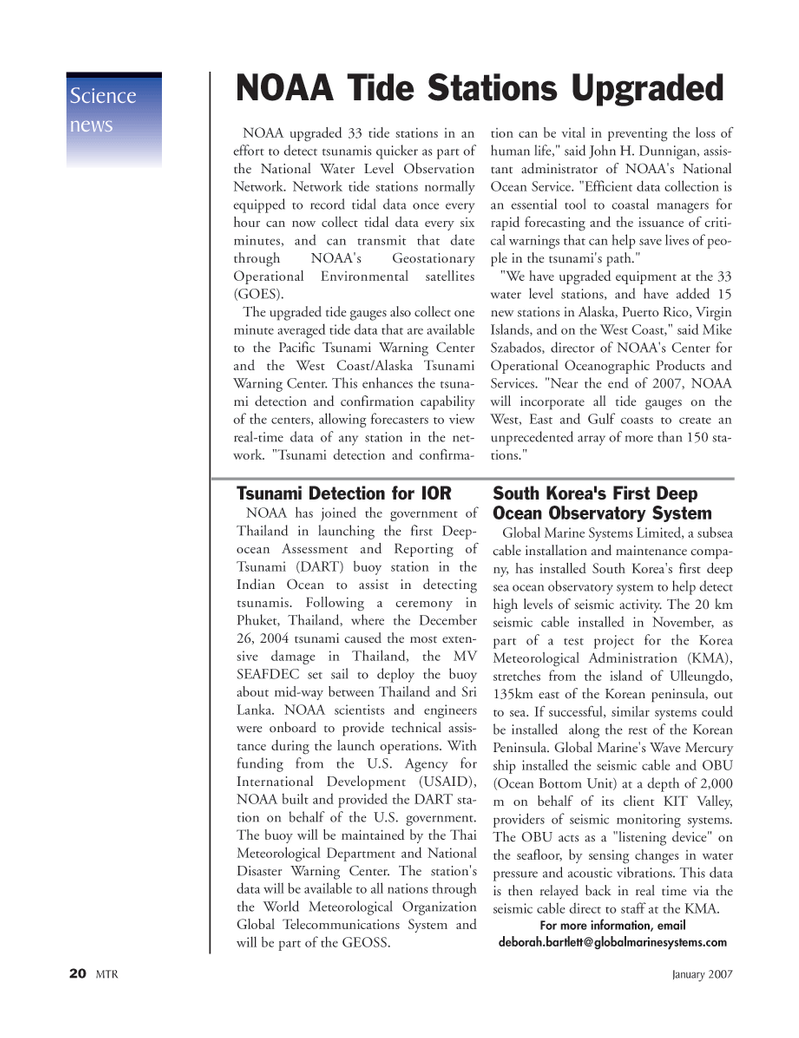
Page 20: of Marine Technology Magazine (January 2007)
Seafloor Engineering
Read this page in Pdf, Flash or Html5 edition of January 2007 Marine Technology Magazine
NOAA upgraded 33 tide stations in an effort to detect tsunamis quicker as part of the National Water Level Observation
Network. Network tide stations normally equipped to record tidal data once every hour can now collect tidal data every six minutes, and can transmit that date through NOAA's Geostationary
Operational Environmental satellites (GOES).
The upgraded tide gauges also collect one minute averaged tide data that are available to the Pacific Tsunami Warning Center and the West Coast/Alaska Tsunami
Warning Center. This enhances the tsuna- mi detection and confirmation capability of the centers, allowing forecasters to view real-time data of any station in the net- work. "Tsunami detection and confirma- tion can be vital in preventing the loss of human life," said John H. Dunnigan, assis- tant administrator of NOAA's National
Ocean Service. "Efficient data collection is an essential tool to coastal managers for rapid forecasting and the issuance of criti- cal warnings that can help save lives of peo- ple in the tsunami's path." "We have upgraded equipment at the 33 water level stations, and have added 15 new stations in Alaska, Puerto Rico, Virgin
Islands, and on the West Coast," said Mike
Szabados, director of NOAA's Center for
Operational Oceanographic Products and
Services. "Near the end of 2007, NOAA will incorporate all tide gauges on the
West, East and Gulf coasts to create an unprecedented array of more than 150 sta- tions."
NOAA Tide Stations Upgraded 20 MTR January 2007
Science news
Tsunami Detection for IOR
NOAA has joined the government of
Thailand in launching the first Deep- ocean Assessment and Reporting of
Tsunami (DART) buoy station in the
Indian Ocean to assist in detecting tsunamis. Following a ceremony in
Phuket, Thailand, where the December 26, 2004 tsunami caused the most exten- sive damage in Thailand, the MV
SEAFDEC set sail to deploy the buoy about mid-way between Thailand and Sri
Lanka. NOAA scientists and engineers were onboard to provide technical assis- tance during the launch operations. With funding from the U.S. Agency for
International Development (USAID),
NOAA built and provided the DART sta- tion on behalf of the U.S. government.
The buoy will be maintained by the Thai
Meteorological Department and National
Disaster Warning Center. The station's data will be available to all nations through the World Meteorological Organization
Global Telecommunications System and will be part of the GEOSS.
South Korea's First Deep
Ocean Observatory System
Global Marine Systems Limited, a subsea cable installation and maintenance compa- ny, has installed South Korea's first deep sea ocean observatory system to help detect high levels of seismic activity. The 20 km seismic cable installed in November, as part of a test project for the Korea
Meteorological Administration (KMA), stretches from the island of Ulleungdo, 135km east of the Korean peninsula, out to sea. If successful, similar systems could be installed along the rest of the Korean
Peninsula. Global Marine's Wave Mercury ship installed the seismic cable and OBU (Ocean Bottom Unit) at a depth of 2,000 m on behalf of its client KIT Valley, providers of seismic monitoring systems.
The OBU acts as a "listening device" on the seafloor, by sensing changes in water pressure and acoustic vibrations. This data is then relayed back in real time via the seismic cable direct to staff at the KMA.
For more information, email [email protected]
MTR#1 (17-32).qxd 1/11/2007 3:54 PM Page 20

 19
19

 21
21
